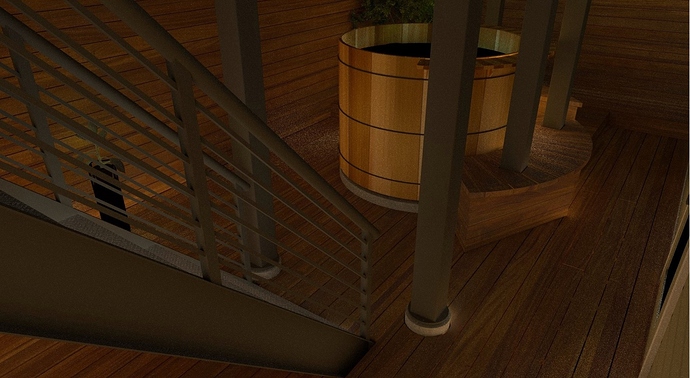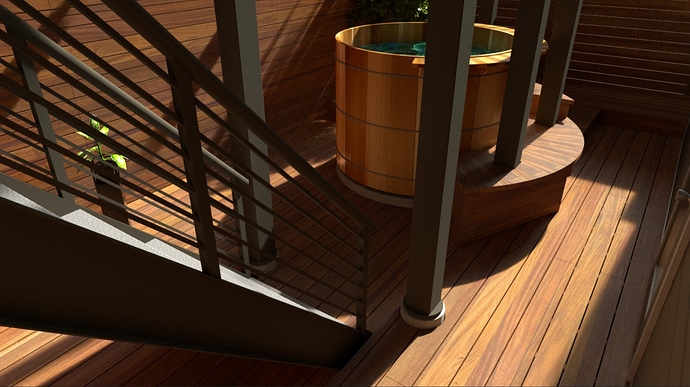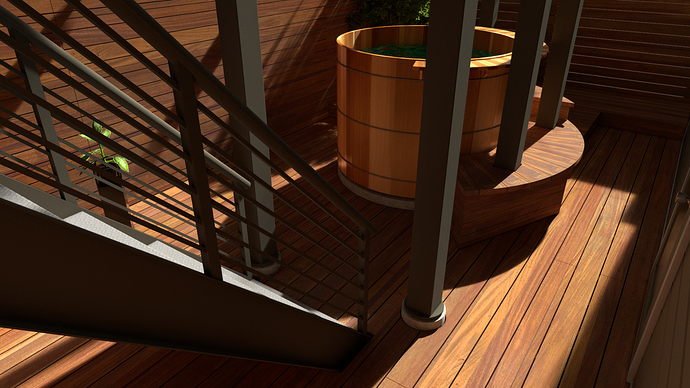Hey gang,
Taking some time with a current project to better understand some lighting techniques and variables has me interested in gaining a more comprehensive understanding of Global Illumination.
For example, below is a SS of a rendering with a little bit of post as well as the GI layer:
Looking at the GI layer, I see the white speckling in the shadow area to the back left of the tub and the right of the tub on the bench. Rather than have to push it further in post, I am aiming to understand why the GI is seemingly grouping heavily in those spots so that I may prevent it before rendering.
I’ve read this post: https://community.keyshot.com/forum/t/when-to-increase-global-illumination-bounces/263?u=imauserwiththisname which provides some good insight into white color issues and fixes. Is there something seemingly similar in my scene that could be adjusted?
I am familiar with some techniques to reduce this in post, but wanted to see what folks are doing in the scene to diminish it instead.
Any guidance, whether to further resources or experiences, will be greatly appreciated.
Cheers,
M
Did you try to turn on firefly filtering?
Hi @oleksii.rybakov,
I do indeed have the firefly filter turned on, thank you for checking.
I could likely crank it a bit more as I have it set relatively lower, but curious if there is anything else that can be done scene/material-wise to limit the result.
Those are not really fireflies I think but more a shortage of light reaching the darkest area’s of the image. I don’t know how many GI bounces you currently have but you can up those. I think the denoiser would also clean it up but maybe you don’t want to use it.
For most renderers such dark area’s are quite hard to render but more bounces should help. Not sure how rough the wood material is but maybe it even helps if you make it a bit less rough. You can also cheat a bit and for the renders from this point of view you activate an area light which will help to render the scene. Another thing you could maybe try is to combine the wood in a composite node with occlusion. That will basically render the corners darker, but more realistic I think, and might cover up the lack of light in already dark area’s.
But it’s a bit of trial and error I think, I use the region render mostly if I need to solve these kind of things.
Hi Oscar,
Thank you very much for sharing this expertise and direction. I am going to experiment with all of the variables mentioned in the coming days to see what I can come up with.
It makes more sense to me that this is lack of GI than too much GI, so I appreciate you mentioning that.
Happy rendering,
M
I was just thinking, maybe it also helps to have some walls around your scene, guess it’s an exterior scene. Maybe a bit of a hard limit for the lights to bounce around gets some more light into the place as well. Good luck, looks great already!
That’s a great point Oscar! I may have gone too literal with the idea of an exterior scene without considering what the render engine actually needed to succeed. 
Going to work on testing out a variety of different approaches based on what you’ve outlined and will report back.
Appreciate the feedback!
I was thinking maybe the ‘ground size’ of the environment actually limits the render as well but if I look in the manual it only mentions to have impact on ground shadows. It might use a bounding box with some margin but especially in imported exterior scenes that might be a really big box.
Had a bit of time to play with this today and was able to find a solution based on your suggestions!
- Doubled the GI bounces
- Composited the occlusion texture with the wood textures for the material diffuse node
- Enclosed the scene in 6 transparent planes (this helped the most)
- Overlaid and tweaked the AO layer in PS
Greatly appreciate the direction.
Cheers,
M
1 Like
Nice!! The good thing about questions like yours is that I also learn a lot. Every scene is different and it’s nice to hear what the results were and what worked best. Curious about the end result!
1 Like



